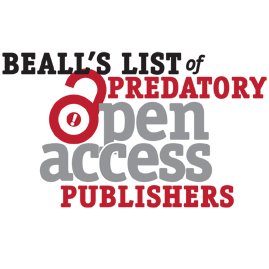
A Trojan horse?
[Note: This is a guest blog post by Dr. Tansu Küçüköncü].
Thales Academic Publisher publishes 23 open-access journals and organizes scholarly conferences. It also publishes academic books. It is included on the list of questionable publishers.
Strangely, two of its journals (the International Journal of Advanced and Multidisciplinary Social Science (JAMSS) and the International Journal of Advanced and Multidisciplinary Engineering Science (JAMES)) are also found on the website of another publisher, Scientific & Academic Publishing (SAPUB), which is also included on the list of questionable publishers.
Also, seven of the publisher’s journals (JNSR, JEDS, JBAH, JIEA, RJFA, RHSS, JSTR) are included on another publishing platform, that of the International Institute for Science, Technology and Education (IISTE), a publisher is also on the list. It is emphasized that six of the journals in IISTE (all except JSTR) have been published for at least five years.
It is said that all seven journals in IISTE are published jointly by both Thales Academic Publisher and IISTE. However, when you access the journals through the IISTE website, there is no indication that the journals also appear on the Thales Academic Publishing website.
The editor-in-chief of the two SAPUB / Thales journals is the same, Fikret Mazi. Fikret Mazi is also the editor-in-chief of three of the IISTE journals.
One of the journals, the International Journal of Thales Solar Energy Reviews (JTSER), which promises fast publication in 20 days, is supported by TÜBİTAK (the Scientific and Technological Research Council of Turkey). Its editor-in-chief is Furkan Dincer.
Thales Publisher also has thirteen additional journals which also promise fast publication in 20 days.
It is interesting that Thales Academic Publisher (Tales Akademik Yayincilik) has no physical address, nor does it list a phone number. Probably it has no official registration anywhere. The only way to contact Thales Publisher is through an anonymous e-mail, thales.editors@gmail.com.
Although its website (http://www.thalespublisher.com) has no information about who its owner is, it’s possible the owner is Omer Faruk Farsakoglu.
The mysterious / fictitious / anonymous / unofficial Thales Academic Publisher, which is contactable only via an anonymous email, is sponsoring several conferences with Kilis 7 Aralık University in Turkey in 2016 at several locations.
The chair of these conferences is Ömer Faruk Farsakoğlu. The conference at Kilis 7 Aralik University — to be held 19-20 March 2016 (International Conference on Natural Science and Engineering (ICNASE ’16)) — is interesting because it has dozens of Turkish university directors (vice rectors, deans) as scientific committee members.

Retraction notice for plagiarism; the author is now a conference organizer in Turkey.
In 2005, Ömer Faruk Farsakoğlu had a paper retracted because of plagiarism. Part of the retraction notice appears in the image above.
According to new Turkish academic regulations, publishing articles in any journal or conference proceeding are enough to be an associate professor and then full professor.
Moreover these articles bring salary promotions, up to 20 percent, to their authors. Prizes (such as best paper awards) given by any journals and conferences are also effective for promotion to associate professor and to gain salary promotions.
Articles in journals that have published for five years or more bring more academic credit.
Being the editor of any journal or organizing any conference is also an effective way to be promoted to associate professor and to gain salary increases.
Under the old system, having one or two SCI (or the equivalent of it for other disciplines) articles was the requirement. The new system did away with this requirement.
Since 2011, the TÜBİTAK ULAKBİM index for Turkish journals (which includes some journals which were deleted from SCI) (which includes 2 year-old journals) (inclusion criteria of which is suspicious) (deletion is almost impossible) is accepted as equivalent to SCI (and its equivalents for other disciplines).
(ULAKBİM: Ulusal Akademik Ağ ve Bilgi Merkezi = National Academic Network and Information Center)
TÜBİTAK is problematic. There are some journals which are directly published by TÜBİTAK. One of the basic and major problems is that it refuses to retract even some 100% plagiarized articles, if the article is older than 5 years. Its decisions, especially details (how they decided, who decided), about ethical violations are secret. It refuses to share data used in articles.
The new system can be summarized as: Everything is acceptable.
In Turkey, associate professor is a title awarded by Turkey’s Council of Higher Education (YÖK).
YÖK (or HEC) has no white or black list for journals and publishers. In the new system, publishing in Turkish journals and being cited six times in Turkish journals (there is way to determine these citations) are the new requirements.
In the new system, conferences are promoted. YÖK has no white or black list for conferences and conference organizers.
New salary promotions, up to 20%, are in parallel to this new system.
Turkish academy is very problematic. The new system and the new salary promotions will create a crisis situation that will be unfixable.
The immediate consequences will be:
- An increase in the number of gold (author-pays) publishers specializing in quick, easy, and cheap scholarly publishing.
- New Turkish journals and publishers and conference organizers and “international” conferences by Turkish academics and Turkish citation rings.
Thales was an ancient Greek philosopher from Miletus on the Aegean coast of Anatolia.



































